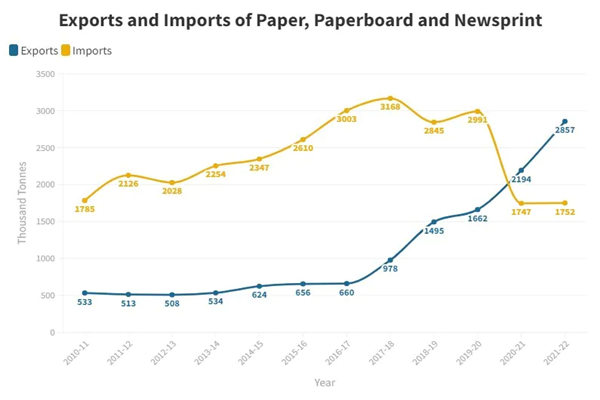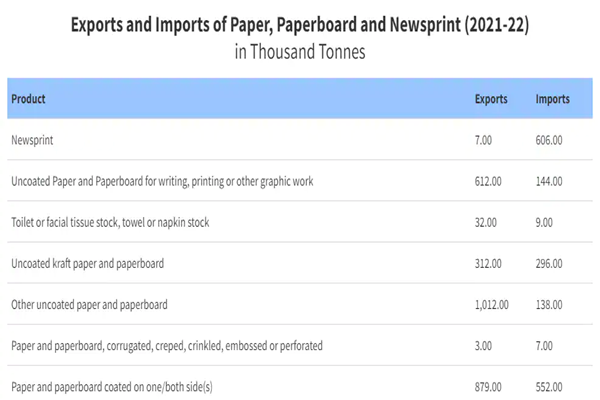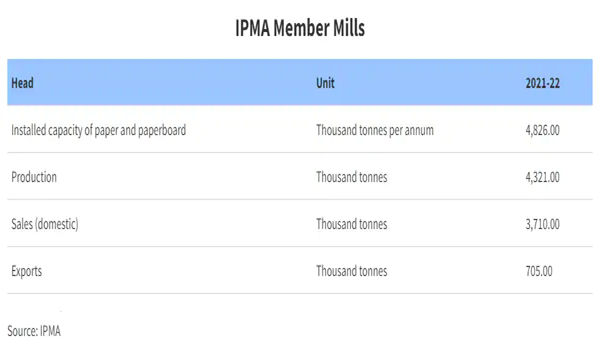27 July 2022
Tide has turned for paper industry and plastic ban provides another shot in the arm

Until a few years ago, the paper industry’s prospects looked in danger with growing digitisation. Then the global supply of pulp was hit because of the COVID pandemic, and production costs rose due to the Russia-Ukraine war.
But the tide seems to be turning now, with India becoming a net exporter of paper. The future, too, seems bright, thanks to the recently implemented plastic ban.
From importer to exporter
Global production was impacted when Europe — which accounted for about a quarter of world production of pulp and paper — went under lockdowns. “Demand-supply mismatch led to an increase in prices of the pulp and paper prices went up in domestic and international markets," Archana Gude, an equity research analyst at IDBI Capital Markets, said
She said gas disruption due to Russian sanctions also hit production. "In the domestic market, organised players per se are not dependent on global production because they use domestic pulp for paper manufacturing. But domestic paper prices follow the trend of global paper prices," Gude said.
S Ranganathan, head of research at LKP Securities, also told CNBCTV18.com that the pandemic- and war-induced global economic crisis increased input costs for various industries, and things were not different for paper manufacturers.
But these crises also meant the demand surged, and amid this chaos, India became a net paper exporter.

"In value terms, exports of coated paper and paperboard increased by 100 percent, uncoated writing and printing paper by 98 percent, tissue paper by 75 percent, and kraft paper by 37 percent," according to Indian Paper Manufacturers Association (IPMA).
The rise in exports is also reflected in the way the stocks of the major companies have moved in the past three years.

Source: DGCI&S
"The rise in exports is also reflected in the way the stocks of the major companies have moved in the past three years.
|
Companies |
% gain year-to-date |
% gain/loss in the past three years |
|
JK Paper |
62.5 |
187 |
|
West Coast Paper Mills |
56 |
61 |
|
Tamil Nadu Newsprint and Papers |
75 |
28.5 |
|
Andhra Paper |
58 |
-21 |
|
Seshasayee Paper & Boards |
41 |
19 |
Fresh tailwinds for the sectorThe recently implemented single-use plastic (SUP) ban is one of the major tailwinds for the sector. India banned the manufacturing, import, stocking, distribution, sale and use of SUPs from July 1.
While the decision created chaos among fast-moving consumer goods (FMCG) companies that used plastic straws and wrappers for most of their products, the paper sector gained as their products would be the most viable alternative available.
Ranganathan said companies with board capacity would definitely get a booster due to the plastic ban. The board, or paperboard, is a paper-based thicker material mainly used for packaging and is seen as the most viable alternative to paper. Listed players like JK Paper and West Coast Paper have a high board capacity.
So, which paper companies might benefit the most?
JK Paper: Archana Gude considers JK Paper as one of the companies that would benefit the most given their pan India customer base and leads in market share in many segments.
West Coast Paper Mills: Gude believes that the company will hugely benefit from the ban on single-use plastics as 95 percent of the company's revenue comes from the paper and paper board division.
ITC: The paper division has been developing an alternative to SUPs for some time now. The division has also been producing biodegradable and recycled boards that can be used by the food and beverage industry as a replacement for SUPs.
Seshasayee Paper & Boards: Ranganathan believes that a mid-cap company like Seshasayee will also grow because of its board capacity, even though it is not comparable with the larger players like JK Paper and West Coast.
Scope for more
Another tailwind for the industry is the implementation of the new syllabus next year. The firms making paper for these books will earn extra revenue.
Talking about the rise in demand, Gude said: "Packaging segment is doing very well. It is almost 40 percent of the total paper utilisation. Then schools and offices drive the demand for writing and printing paper."
With the rise in demand, manufacturers have balanced out the increase in input costs by raising retail prices.
Ranganathan said that the price rise has balanced the increase in input costs and manufacturers and has boosted business, adding, “In fact, today, India is an exporter of paper.”
And, there is scope for more production with existing facilities as IPMA member mills' capacity utilisation has been at 89.55 percent.

Source: https://www.cnbctv18.com/business/tide-has-turned-for-paper-industry-and-plastic-ban-provides-another-shot-in-the-arm-14110932.htm